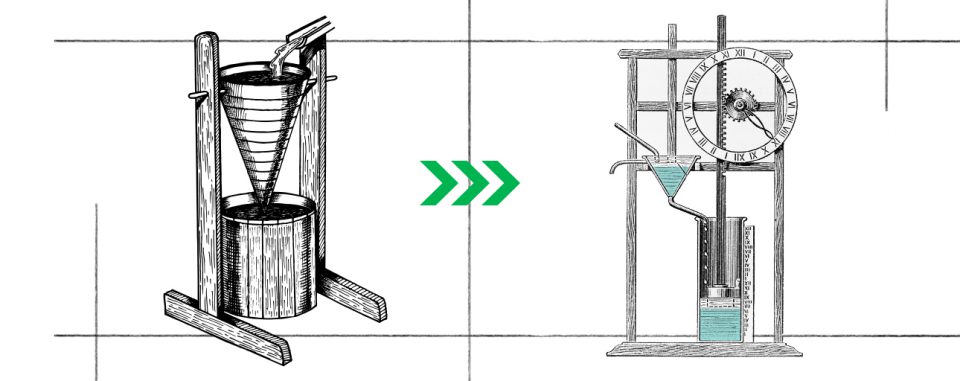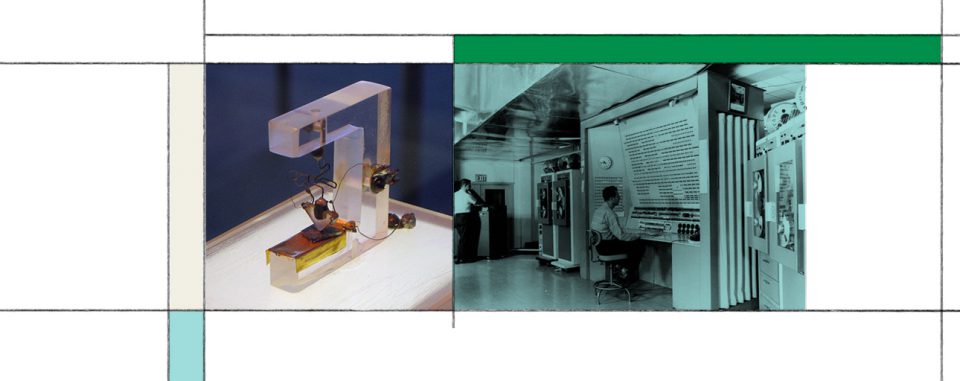As a term and as a concept, “automation” may seem relatively modern, maybe even futuristic. But in some sense, the efficiencies and conveniences of the digital era are the logical result of thousands of years of human progress.
Looking back to the beginning
When ancient Babylonians and Egyptians used water clocks, they were attempting to make life easier. After all, if time can be measured by water dripping into containers with evenly spaced markings, then timekeeping was a job that human beings no longer had to do. Appropriately, having the right tool freed them to focus on other things.
 But what about actual jobs in a relatively recognizable economy? Enter the Industrial Revolution. With groundbreaking 18th-century inventions like the Watt steam engine and the power loom, massive amounts of “labor” could be accomplished through machinery, enabling a new era of mass production. However, it was not until 1946 that the term “automation” was coined in reference to the use of automatic controls in Ford Motor Company’s production lines.
But what about actual jobs in a relatively recognizable economy? Enter the Industrial Revolution. With groundbreaking 18th-century inventions like the Watt steam engine and the power loom, massive amounts of “labor” could be accomplished through machinery, enabling a new era of mass production. However, it was not until 1946 that the term “automation” was coined in reference to the use of automatic controls in Ford Motor Company’s production lines.
Around this same time, a primitive form of computers captured the minds of scientists and engineers. The year 1947 saw the introduction of the electronic semiconductor, setting the stage for the next few decades of computing advancements and culminating in the “digital reality” that became an increasingly familiar fixture of life — and the workplace — as the 20th century wound to a close.
With the early part of the current century came a seemingly exponential acceleration of that technology. “The cloud,” or internet-based computing services, brought new speed and efficiency to data collection and analytics. Considering these tasks once required significant expenditures of human time and labor, the implications for the world of work cannot be overstated.
Even smartphones and their apps, which are heavily associated with our personal lives, can now be put to the task of making our work lives easier, too. Let’s look at exactly how they do it.
Getting back to the future
Have you ever wondered why so many organizations have yet to fully embrace automation, especially in their HR functions?
For example, consider what automation might look like for payroll processing. Rather than relying on error-prone manual data entry (and/or reentry) of information, HR professionals can now opt for the right tool in the form of software that takes them out of the data-transfer process. This cutting-edge alternative can reduce inaccuracies, making incorrect paychecks a thing of the past through employee-driven payrolls.
The accuracy of an automated payroll provides obvious time advantages, but when the streamlined processes become part of regular operations, even greater benefits start to manifest downstream.
By enabling more accurate data, automated payroll processes also provide lowered employer liability, delivering a huge leap forward for HR tech with companywide benefits each and every cycle. The C-suite can appreciate a healthier bottom line, while HR gains time to explore and pursue opportunities for a more strategic, people-focused approach to its role.
When essential processes are automated — everything from payroll to scheduling to reporting and beyond — the results are profound. Ready to step into the future of HR technology? Simply schedule a demo to learn more about what Paycom’s digital tools can automate for you.
DISCLAIMER: The information provided herein does not constitute the provision of legal advice, tax advice, accounting services or professional consulting of any kind. The information provided herein should not be used as a substitute for consultation with professional legal, tax, accounting or other professional advisers. Before making any decision or taking any action, you should consult a professional adviser who has been provided with all pertinent facts relevant to your particular situation and for your particular state(s) of operation.
